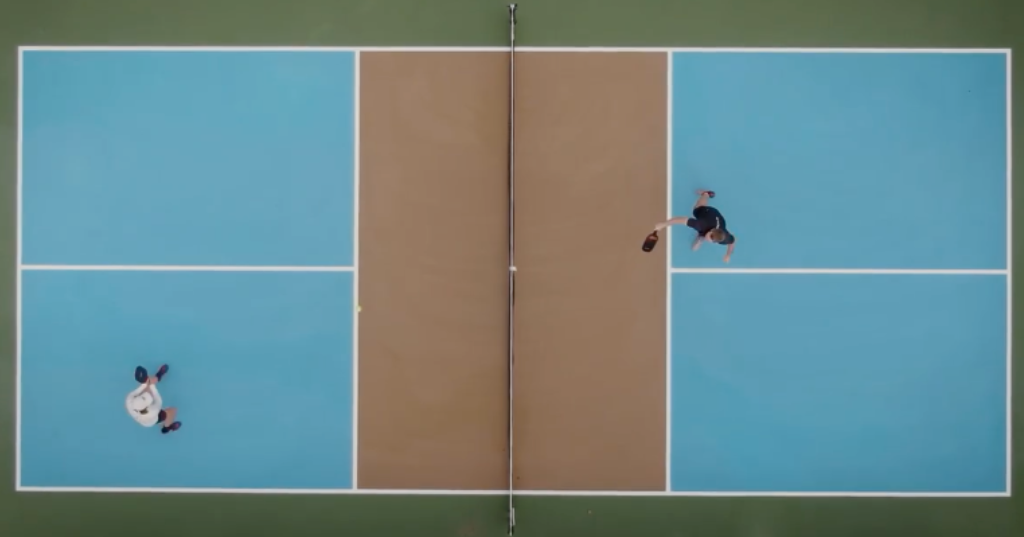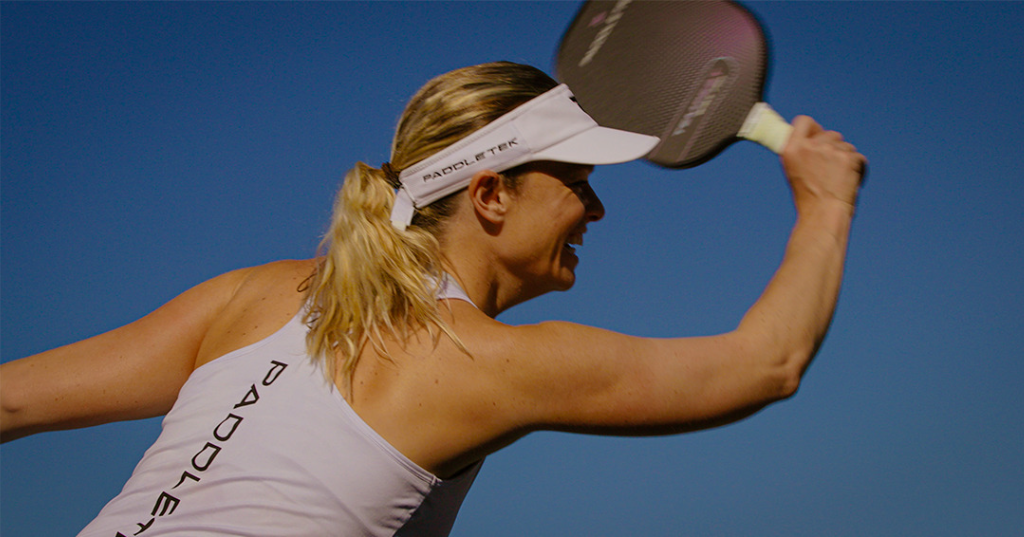Unless you’re playing purely for fun, you and your opponent(s) are going to have to begin keeping score when playing pickleball. If the only thing you know about scoring is that games go to 11, then you might be wondering, how you keep score and ultimately win.
Pickleball scoring varies by singles and doubles play, with the score represented as 2 numbers in singles play and 3 numbers in doubles play. Serving players are required to audibly call out the score ahead of serving. The first player or team to score 11 with a 2-point margin wins.
Pickleball scoring can be a bit nuanced, but we’ll take you through all the ins and outs and simplify along the way. You’ll learn how singles and doubles scoring methods are different and how to keep score so you can be sure who the winner is!
What Are the Numbers in a Pickleball Score?
First, we have to talk about how a pickleball score is displayed, as it can be confusing to beginners.
If you’re playing singles (one vs one), the score will have 2 numbers. In doubles (two vs two), it’s 3 numbers. The first and second numbers are the serving and receiving player(s)’ scores, respectively. The third number, for doubles, corresponds to the two servers during their right to serve.
That third number, the server number, can trip some players up. But since you have to call a score aloud when serving, you need to know how to announce scores correctly. Let’s decipher what the numbers mean so you can do exactly that.
Keeping Score in Singles Play - Two Numbers
This is easy, especially if you’ve ever seen how basketball and football display their scores.
In pickleball, the number on the left represents the server’s score, and the number on the right represents the receiver’s score. These numbers can be either single or double digits since pickleball games are typically played to a score of 11 and the winner must be ahead by at least 2 points.
In some tournaments, the winning score can be bumped up to 15 or even 21, but the most common winning score will be 11 points.
If the score is displayed as 10-8, that means the server needs 1 more point to reach 11, which will win the game by at least 2 points.
Keeping Score in Doubles Play - Three Numbers
In doubles, the score will have 3 numbers.
The first digit is the serving team’s score. The second digit is the receiving team’s score, and the third digit is the server number. In doubles, each side gets its two serves, so the third digit in the score represents whether the serving side is on its first or second serve.
For instance, imagine the score is 10 - 8 - 2. This means the serving team has 10 points, the receiving team has 8 points, and the serving team is on their second server.
While the scores can go to 11 or beyond, the third number will never be higher than 2.
When you state the score in doubles, you should state all 3 numbers aloud.
How Is Scoring Done in Pickleball?
In many sports, a player or team can score just about anytime, but that’s not the case for pickleball. Let’s explain the scoring in more detail now, because it's unlike many other sports.
How Do You Score in Pickleball?
Only the serving side can score, meaning the receiving side can’t score, even when the serving side commits a fault. This applies to singles, skinny singles, and doubles alike. This means the goal in pickleball is to get your opponent to fault, aka make a mistake or break one of the rules.
For the serving side, the opponent’s fault means a point. For the receiving team, the opponent’s fault means the serving side either switches servers or sends the serving opportunity to the receiving team so that they have a chance to score. Pickleball has many rules around faults. For a full guide, check out Paddletek's guide on how to play pickleball.
But a few general principles include serving to the proper zones, following the double-bounce rule, preventing your paddle from touching the net or your opponent, holding the correct stance, and not volleying in the non-volley zone.
The list is extensive, which is one of the reasons it’s worth understanding the ins and outs of pickleball rules. You need to know the fault rules inside and out so you don’t fault when playing (or at least not too much).
How Do You Keep Track of Your Pickleball Score?
It’s common, especially among beginner players, to lose track of their score.
It’s not necessarily that they’re playing so passionately that they just sort of forget about the score. It’s more likely they’re not verbally keeping track of the score in the first place.
Complete beginners might not know to do this, but more seasoned players, even those with a few games under their belts, should.
Don’t rely on your opponent or teammate to call out the score. You’re supposed to do it when it’s your turn to serve, just as your opponent should do it when it’s their turn.
Pickleball courts don’t always have scoreboards, especially if it’s a court used only for casual games. There may not be any observers either. It could be just you, your partner (if you’re playing doubles), and your opponent(s).
Calling out the score is to everyone’s advantage.
You can’t win if you don’t know what the score is, and a game of he-said, she-said can quickly devolve when competitive feelings get in the way.
And if you have dreams of competitive play at tournaments, then you should know that players at those events are required to shout out the score. It's certainly a courtesy in any scenario, but it's also a requirement to call the score in USA Pickleball's set of rules (4.D.)
Separate but semi-related, you should never stop play after the serve only with the purpose to point out that a score was called incorrectly. If you do, this will result in a fault for your side (USA Pickleball Rule 4.K. - Wrong Score Called.)
So don’t wait until you’re at a tournament trying to learn to verbally proclaim the score. Get into the habit now.
What If I Forgot My Pickleball Score or Lost Track?
If you're someone who struggles to keep track of the score, there are two options to help you; either using a scoring app or manually tracking where players are standing manually.
1. Keeping Score With a Pickleball App
You can download a free pickleball scoring app. These apps work best when operated on wearable tech devices such as a smartwatch. The app will ask you basic questions like who’s serving and then vibrate when it’s your turn to serve or when the score changes.
2. Manually Track Where Players Are Standing
Your other option is to keep track of who’s standing where. And regardless of singles or doubles, this is the best time to mark the scoreline in your mind, in case you lose track during your serve.
In singles, if the score is even, the serve will come from the right side, and odd, the serve will come from the left side. Similarly, in doubles, the person who served first on a team will be on the right side facing the net if their team's score is even, and the left side if their team's score is odd.
For doubles, if you can just remember which player served first on your team, you’ll be able to track whether the score is odd or even based on where they’re standing.
Will manually tracking where you stand tell you the precise number of points you’ve scored in singles or doubles? No, of course not. It’s just a guesstimate. You could have 2 points or 10.
But it does provide a great starting point for tracking back to a point when you did remember.
How Do You Keep Score in Singles Pickleball?
The scoring system is simpler for singles. Here’s what you need to know.
If you have an odd-numbered score, you’ll serve from the left side of the court, and if you have an even-numbered score, you'll serve from the right side. The odd- or even-numbered score refers to the server’s score, not the receiver’s score.
The receiver, regardless of their score, will serve from the left or right side of the court, based on the server’s score.
When calling the score aloud, all you have to do is state the server’s score and the receiver’s score. Using the 10-8 example from earlier, you’d announce, “10, 8,” then serve.
How Do You Keep Score in Doubles Pickleball?
The majority of pickleball is played as doubles, so knowing how to keep score is incredibly important. Here's how to do it:
Keeping score in doubles follows rules that are similar, but not identical, to singles. Doubles players can also score only when serving, but not receiving. In singles and doubles, if the score is even, the serve will come from the right side. But in doubles, the person who served first will be on the right when the score is even. And they'll be on the left side of the court when the score is odd.
So if they score a point on the even side (right side), they move to the odd court (left side) to serve again. They continue to switch after each additional point.
The same is true of your opponents when they’re serving.
The movement of serving positions is purposeful. For instance, if a team doesn’t score a point during their serve, they don’t switch sides.
That said, your team serves until a fault occurs on your side. When the first server faults, then their partner gets the chance to serve.
And remember: No one changes positions when receiving.
What is the First Server Exception?
Under the First-Server Exception rule, the player with the first serve of the game in doubles plays to fault. Once they lose the serve, the other team gets the serve. First-Server Exception decreases the advantage of serving first in pickleball since a team can serve until faults are committed.
In other words, the team that opens the game has only one server. After that, both players on each side serve until there’s a fault.
The original serving player is on the right side of the court and is known as the designated second server. They announce a score of 0 - 0 - Start or 0 - 0 - 2, with Start or 2 representing their status as the designated second server.
Remember, whenever you're calling the score, always use the 3-number sequence of server score, receiver score, and server number.
What Is Traditional Scoring in Pickleball?
To wrap up, let’s talk about traditional versus rally scoring, as these are two unique forms of scoring that you’ll come across if you play pickleball long enough.
Traditional scoring rules dictate that a singles or doubles player earns a point only when they’re serving and their opponent commits a fault. Whereas rally scoring allows either the serving or receiving side to score a point, regardless of who served.
Rally Scoring 101
The biggest advantage of rally scoring is that it increases the speed of a game. They typically go 20% faster since points are scored that much quicker. Because of this, rally scoring games often play to 15 or 21 points instead of 11.
Some tournaments incorporate this into their play.
If the server doesn't score a point, then the other team gets to serve.
In rally scoring, the server follows the position per score number, where the right side is for even scores, and the left side is for odd scores.
However, rally scoring isn’t in the official pickleball rule book. It’s a somewhat unconventional means of playing pickleball and something that only some organizations are willing to embrace.
For beginners, traditional scoring is the recommended way to play. It's far more commonly used, and a different scoring system can be confusing to new players.
Rally scoring is out there, and it’s good to know about it just so you can understand how it’s different than traditional scoring. But, it’s not the scoring system that pickleball purists use, so it shouldn’t be the scoring system for someone new to the sport.
Keeping Score and Having Fun
Tracking your score in pickleball is an important component of winning, but remember that winning isn’t everything. When you’re just getting started in the game, learning the rules and how to score are part of playing and having fun.
There's no need to study the rule books every night. Go ahead and lose yourself while playing the game.



Leave a comment
This site is protected by hCaptcha and the hCaptcha Privacy Policy and Terms of Service apply.